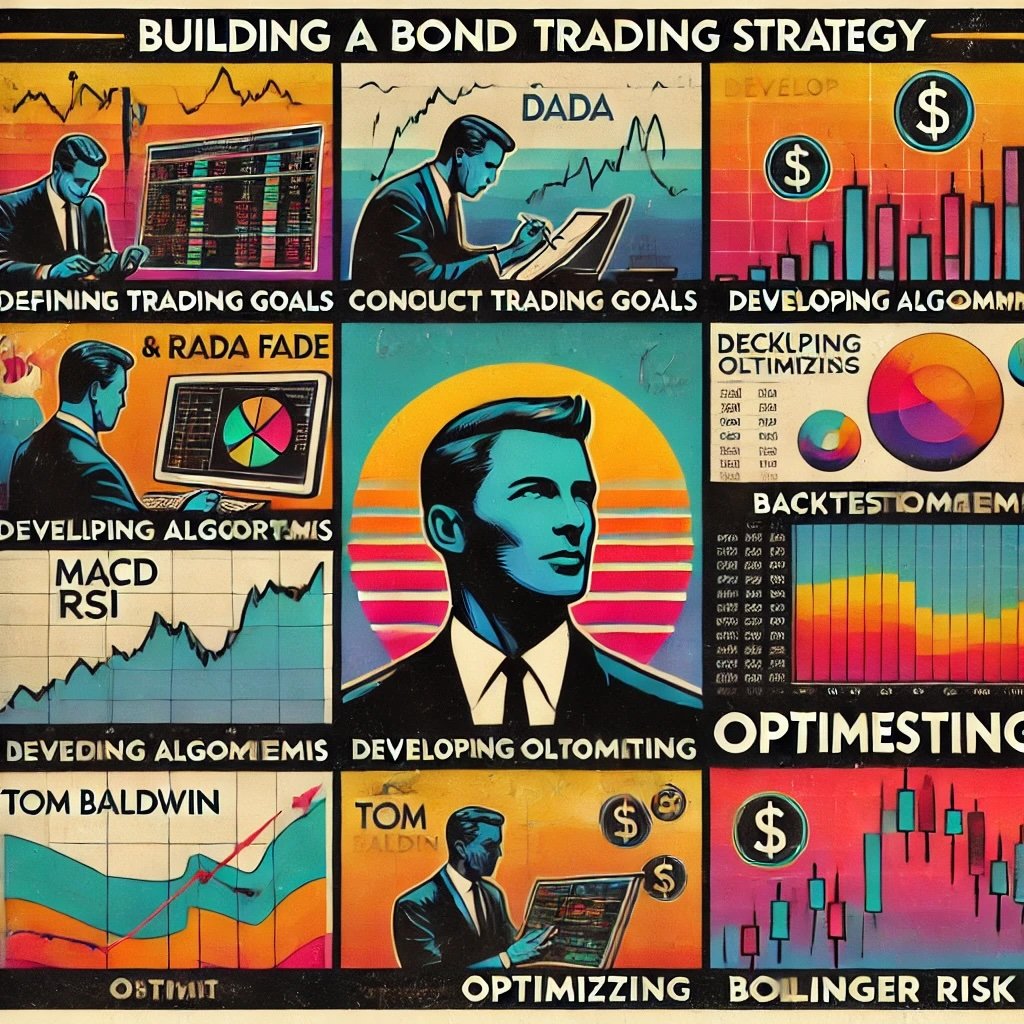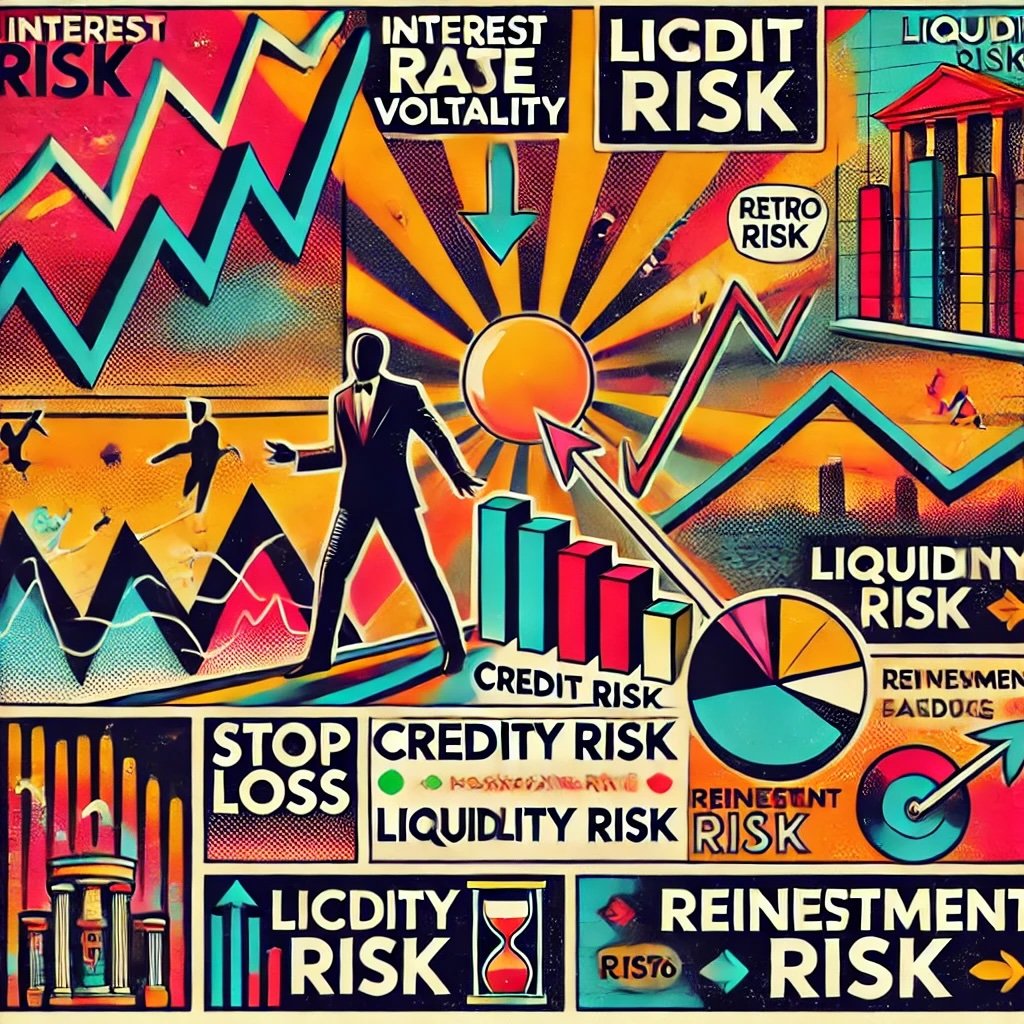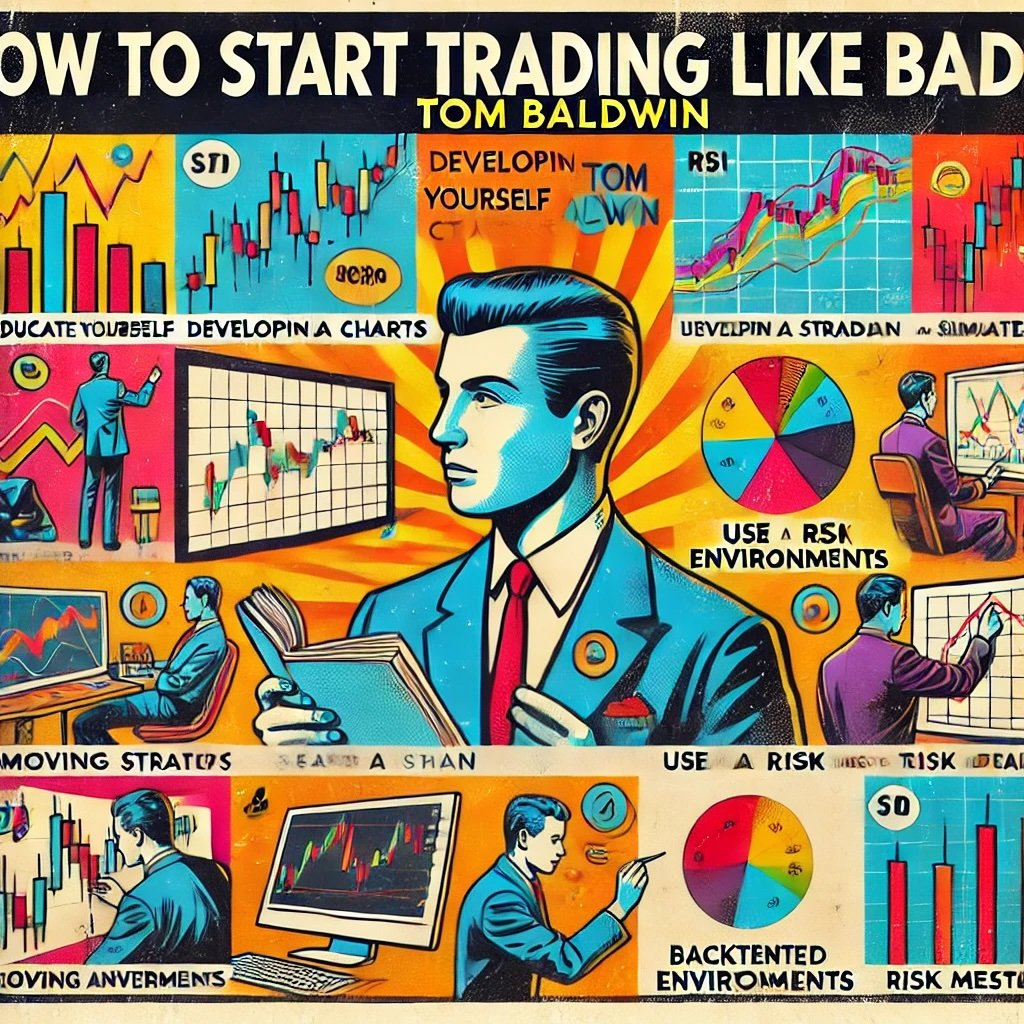Investing like Tom Baldwin involves mastering the intricacies of bond trading, leveraging strategic risk management, and cultivating psychological resilience. Renowned as a prominent bond trader, Baldwin has significantly influenced the bond trading landscape through his insightful strategies and disciplined approach. Whether you’re a novice investor or a seasoned trader, adopting Baldwin’s principles can elevate your trading game, leading to enhanced performance and sustained success. In this comprehensive guide, we’ll delve into Tom Baldwin’s trading philosophy, explore his core strategies, and provide actionable insights to help you emulate his success in the bond trading arena.
source: Kellymichellefx on YouTube
Tom Baldwin: A Titan in Bond Trading
Tom Baldwin stands as a monumental figure in the realm of bond trading. His remarkable journey from a floor trader to a leading bond trader underscores the profound impact of strategic thinking and disciplined execution in financial markets. Baldwin’s innovative approaches and consistent success have inspired countless traders, solidifying his legacy as one of the most influential bond traders of his time.

Understanding Bond Trading and Its Significance
Bond trading involves buying and selling debt securities, primarily to capitalize on fluctuations in interest rates and credit quality. As a cornerstone of the global financial system, the bond market plays a crucial role in financing governments, corporations, and other entities. Its significance lies in providing investors with opportunities to generate income, preserve capital, and diversify their investment portfolios.
Here we’ll explore Tom Baldwin’s trading strategies and his profound influence on the bond trading industry. By understanding his approach, investors can gain valuable insights into building and implementing effective trading systems. From risk management to psychological discipline, we’ll cover the multifaceted aspects that make Tom Baldwin a legendary figure in bond trading.

Who is Tom Baldwin?
Background and Early Life of Tom Baldwin
Tom Baldwin was born in the bustling financial hub of New York City, where he developed an early fascination with the intricacies of financial markets. Growing up in an environment teeming with financial activity, Baldwin was naturally drawn to understanding how markets function and the forces that drive them. His academic journey led him to pursue a degree in finance from a prestigious university, where he honed his analytical skills and deepened his understanding of financial instruments.
Rise from a Floor Trader to a Prominent Bond Trader
Baldwin’s professional journey began on the trading floors of Wall Street, where he worked as a floor trader. The high-energy environment and the relentless pace of the trading floors provided Baldwin with invaluable hands-on experience. His ability to analyze market trends, coupled with his disciplined approach, quickly set him apart from his peers.
In the early stages of his career, Baldwin focused primarily on U.S. Treasury bonds, leveraging their liquidity and stability to build a strong foundation in bond trading. His success on the trading floors caught the attention of major financial institutions, leading to opportunities that allowed him to scale his strategies and influence within the industry.
Key Achievements and Contributions to Bond Trading
- Founding of Baldwin Trading Group: Tom Baldwin established his own trading firm, Baldwin Trading Group, which quickly gained a reputation for its disciplined and strategic approach to bond trading.
- Innovative Trading Strategies: Baldwin is credited with developing several trading strategies that emphasize market timing, volume analysis, and risk management. These strategies have been widely adopted by traders seeking to enhance their bond trading performance.
- Educational Contributions: Beyond trading, Baldwin has contributed to the education of upcoming traders through seminars, workshops, and publications. His teachings focus on the importance of psychological resilience and strategic planning in trading.
- Consistent Performance: Under Baldwin’s leadership, Baldwin Trading Group has consistently outperformed market benchmarks, delivering substantial returns for its investors even during volatile market conditions.

Understanding Bond Trading
What is Bond Trading?
Bond trading involves the purchase and sale of debt securities, primarily issued by governments, municipalities, and corporations. Bonds are fixed-income instruments that pay periodic interest to investors and return the principal amount at maturity. Traders engage in bond trading to capitalize on interest rate movements, credit quality changes, and market sentiment shifts.
Significance in Global Markets
The bond market is the largest financial market in the world, with daily trading volumes exceeding trillions of dollars. It plays a pivotal role in financing governments, corporations, and other entities, enabling them to raise capital for various projects and operations. For investors, the bond market offers opportunities to generate stable income, preserve capital, and diversify investment portfolios, reducing overall risk.
Bond Market Structure and Key Players
The bond market is structured into various segments, including government bonds, corporate bonds, municipal bonds, and agency bonds. Key players in the bond market include:
- Institutional Investors: Such as pension funds, insurance companies, and mutual funds, which manage large portfolios of bonds to meet long-term liabilities.
- Central Banks: Engage in bond trading to implement monetary policy, influence interest rates, and manage liquidity in the financial system.
- Investment Banks and Broker-Dealers: Facilitate bond issuance, trading, and provide market-making services to ensure liquidity.
- Individual Investors: Participate in bond trading through mutual funds, exchange-traded funds (ETFs), and direct bond purchases.
Baldwin’s Focus on U.S. Treasury Bonds
Tom Baldwin has carved a niche in U.S. Treasury bonds, leveraging their high liquidity, low credit risk, and significant market size. U.S. Treasury bonds are considered a benchmark in the bond market, serving as a safe-haven asset and a key indicator of economic health. Baldwin’s expertise in trading U.S. Treasuries has been instrumental in his success, allowing him to navigate and capitalize on interest rate movements and macroeconomic trends effectively.

Core Principles of Tom Baldwin’s Trading Strategy
Tom Baldwin’s trading success is anchored in several core principles that guide his decision-making and execution. These principles ensure that his trading remains disciplined, strategic, and resilient to market fluctuations.
1. Market Timing: The Importance of Timing in Bond Trading
Market timing is a critical component of Baldwin’s trading strategy. The ability to anticipate and react to market movements can significantly enhance trading performance.
Key Aspects of Market Timing:
- Economic Indicators: Baldwin closely monitors key economic indicators such as GDP growth, inflation rates, and employment figures. These indicators provide insights into the health of the economy and influence interest rate decisions by the Federal Reserve.
- Interest Rate Movements: Understanding and predicting changes in interest rates is fundamental in bond trading. Baldwin analyzes Federal Reserve policies and market sentiment to anticipate rate hikes or cuts, adjusting his positions accordingly.
- Technical Analysis: Utilizing technical charts and indicators, Baldwin identifies trends, support and resistance levels, and potential reversal points. This technical insight complements his fundamental analysis, providing a comprehensive view of the market.
2. Volume Analysis: Using Volume as a Key Indicator in Trading Decisions
Volume analysis is another cornerstone of Baldwin’s trading approach. Volume, the number of bonds traded within a specific period, provides valuable information about market strength and potential price movements.
Techniques for Volume Analysis:
- Volume Trends: Baldwin examines volume trends alongside price movements to gauge the strength of a trend. Increasing volume in the direction of the trend indicates strong market conviction.
- Volume Spikes: Sudden spikes in volume can signal significant market events or shifts in sentiment. Baldwin uses volume spikes to identify breakout points and potential trading opportunities.
- Volume Weighted Average Price (VWAP): Baldwin employs VWAP to assess the average price at which bonds are traded throughout the day, providing a benchmark for identifying overbought or oversold conditions.
3. Risk Management: Baldwin’s Approach to Managing Risk in Volatile Markets
Risk management is paramount in Baldwin’s trading philosophy. By controlling risk, Baldwin ensures the preservation of capital and sustains long-term profitability.
Key Risk Management Techniques:
- Position Sizing: Baldwin determines the appropriate size of each trade based on his overall portfolio size and the level of risk associated with the trade. This prevents overexposure to any single position.
- Stop-Loss Orders: Implementing stop-loss orders allows Baldwin to limit potential losses on each trade. These predefined exit points ensure disciplined exits, preventing significant capital erosion.
- Diversification: Spreading investments across different bond maturities, sectors, and issuers reduces the impact of adverse movements in any single area of the bond market.
4. Discipline and Patience: The Role of Psychological Discipline in Trading Success
Discipline and patience are essential traits in Baldwin’s trading approach. By adhering strictly to his trading plan and waiting for high-probability setups, Baldwin minimizes impulsive decisions and maximizes trading performance.
Strategies for Maintaining Discipline and Patience:
- Strict Trading Plan: Baldwin develops and follows a comprehensive trading plan that outlines entry and exit criteria, risk management protocols, and trading goals.
- Avoiding Overtrading: Limiting the number of trades to focus on high-conviction opportunities reduces the likelihood of chasing the market and incurring unnecessary losses.
- Routine and Structure: Establishing a consistent trading routine reinforces disciplined behavior and minimizes emotional interference.
Integration of Core Principles
Baldwin’s trading strategy seamlessly integrates market timing, volume analysis, risk management, and psychological discipline. By combining these core principles, Baldwin creates a robust and effective trading framework that can navigate the complexities of the bond market, ensuring sustained success and profitability.

Famous Trades and Market Calls
Tom Baldwin’s career is punctuated with several notable trades that highlight the effectiveness of his bond trading strategies. These trades not only showcase his ability to capitalize on market opportunities but also provide valuable lessons for traders looking to adopt similar approaches.
1. The U.S. Treasury Yield Curve Flattening Trade
One of Baldwin’s most significant trades involved betting on the flattening of the U.S. Treasury yield curve. Anticipating that short-term yields would rise relative to long-term yields due to Federal Reserve tightening policies, Baldwin positioned his portfolio to capitalize on this trend.
Strategy Behind the Trade:
- Fundamental Analysis: Baldwin analyzed economic data indicating impending interest rate hikes and their impact on different segments of the yield curve.
- Technical Confirmation: Using technical charts, he identified key resistance levels in short-term Treasuries and support levels in long-term bonds.
- Volume Analysis: An increase in trading volume at these levels confirmed the strength of the anticipated yield curve flattening.
Outcome and Impact:
As expected, the yield curve flattened significantly, resulting in substantial profits for Baldwin’s portfolio. This trade underscored the importance of combining fundamental insights with technical and volume analysis to make informed trading decisions.
2. The Long-Term Bond Rally During Economic Recovery
During the post-recession economic recovery, Baldwin identified an opportunity to profit from a rally in long-term bonds. Anticipating that improved economic conditions would lead to increased demand for longer-duration bonds, he increased his exposure to this segment.
Strategy During the Recovery:
- Economic Indicators: Baldwin closely monitored GDP growth rates, employment figures, and consumer confidence indices, which all pointed towards economic recovery.
- Interest Rate Predictions: He anticipated that the Federal Reserve would maintain a cautious stance on interest rates initially, supporting long-term bond prices.
- Technical Breakouts: Baldwin used technical analysis to identify breakout points in long-term bond charts, entering positions as prices broke above key resistance levels.
Outcome and Lessons:
The rally in long-term bonds exceeded Baldwin’s expectations, leading to significant gains. This trade demonstrated the effectiveness of aligning trading strategies with macroeconomic trends and technical signals, reinforcing the importance of comprehensive market analysis.
3. The Bond Market Correction Play
In the face of an unexpected bond market correction, Baldwin swiftly adjusted his strategies to mitigate losses and seize new opportunities. Recognizing that the correction was temporary and driven by short-term market sentiments, he repositioned his portfolio to take advantage of undervalued bonds.
Strategy During the Correction:
- Risk Assessment: Baldwin assessed the extent of the correction and identified which segments of the bond market were most impacted.
- Selective Buying: He selectively purchased bonds that were oversold but retained strong fundamentals, anticipating a rebound as market sentiment normalized.
- Hedging Positions: To protect against further downside, Baldwin employed hedging techniques such as shorting certain bond segments or using derivatives to offset potential losses.
Outcome and Lessons:
The bond market recovered as Baldwin had predicted, resulting in profitable positions from his selective buying and hedging strategies. This trade highlighted the importance of adaptability, quick decision-making, and robust risk management in volatile markets.
Key Takeaways from Baldwin’s Famous Trades
- Combination of Fundamental and Technical Analysis: Integrating macroeconomic insights with technical indicators provides a comprehensive view of market dynamics.
- Discipline and Risk Management: Maintaining strict adherence to trading plans and robust risk controls is essential for navigating market volatility.
- Adaptability: The ability to swiftly adjust strategies in response to changing market conditions can lead to significant profits and minimize losses.
Relevance of Baldwin’s Trades Today
The principles demonstrated in Baldwin’s notable trades remain highly relevant in today’s financial markets. With the advent of new technologies and the evolving economic landscape, the need for a systematic, disciplined, and adaptable trading approach is more crucial than ever. Baldwin’s strategies serve as a timeless blueprint for traders seeking consistent success in the dynamic world of bond trading.

Risk Management Techniques
Tom Baldwin’s Approach to Managing Risk in Bond Trading
Risk management is the bedrock of Tom Baldwin’s trading philosophy. His meticulous approach ensures that capital is protected and potential losses are minimized, allowing for sustained trading success even in volatile bond markets.
1. Position Sizing: Allocating the Right Amount
Position sizing is a critical component of Baldwin’s risk management strategy. Determining the appropriate amount to invest in each trade based on the level of risk is essential for preserving capital and ensuring long-term profitability.
Key Strategies for Position Sizing:
- Fixed Percentage Allocation: Allocating a fixed percentage of the portfolio to each trade ensures that no single trade can disproportionately impact the overall portfolio.
- Volatility-Based Sizing: Adjusting position sizes based on the volatility of the bond being traded. More volatile bonds receive smaller positions to mitigate risk.
- Risk-Reward Assessment: Evaluating the potential risk and reward of each trade to determine the optimal position size, aiming for trades where the potential reward justifies the risk.
2. Stop-Loss Orders: Limiting Potential Losses
Stop-loss orders are predefined exit points set to limit potential losses on a trade. Baldwin employs stop-loss orders as a fundamental component of his risk management strategy.
Implementing Stop-Loss Orders:
- Technical Levels: Placing stop-loss orders at key technical levels, such as support or resistance points, to ensure that they are not triggered by minor market fluctuations.
- Dynamic Stop-Loss: Adjusting stop-loss levels based on market conditions and the evolving trend, allowing for flexibility while maintaining protection.
- Automated Execution: Utilizing algorithms to automatically execute stop-loss orders when predefined conditions are met, ensuring timely and emotion-free exits.
3. Use of Leverage: Balancing Risk and Reward
Leverage can amplify both profits and losses. Baldwin employs leverage cautiously, understanding its potential impact on his trading performance.
Strategies for Managing Leverage:
- Conservative Leverage Levels: Using leverage levels that align with his risk tolerance and trading strategy, avoiding excessive exposure.
- Monitoring Leverage: Continuously monitoring leveraged positions to ensure that they remain within acceptable risk parameters.
- Risk-Adjusted Returns: Evaluating the potential returns against the associated risks to determine appropriate leverage levels for each trade.
4. Diversification: Spreading Risk Across Markets
Diversification involves spreading investments across various bond types, maturities, and issuers to reduce exposure to any single source of risk.
Diversification Strategies:
- Bond Type Diversification: Investing in a mix of government bonds, corporate bonds, municipal bonds, and agency bonds to balance risk and return.
- Maturity Diversification: Spreading investments across short-term, medium-term, and long-term bonds to mitigate interest rate risk and enhance portfolio stability.
- Issuer Diversification: Allocating investments across different issuers to reduce the impact of credit risk associated with any single issuer.
5. Balancing Risk and Reward: Ensuring Sustainable Profitability
Balancing risk and reward is essential for optimizing portfolio performance. Baldwin’s approach ensures that each trade offers a favorable risk-reward ratio, enhancing the potential for sustained profitability.
Strategies for Balancing Risk and Reward:
- Risk-Reward Ratio: Targeting trades where the potential reward significantly outweighs the risk, such as aiming for a 2:1 or 3:1 ratio.
- Thorough Analysis: Conducting comprehensive research and analysis to assess the viability and potential returns of each investment.
- Continuous Monitoring: Regularly reviewing and adjusting the portfolio to maintain an optimal balance between risk and reward, responding to changing market conditions.
Implementing Baldwin’s Risk Management Techniques
To effectively implement Baldwin’s risk management techniques, traders should:
- Define Risk Parameters: Clearly outline the maximum acceptable loss per trade and overall portfolio risk, ensuring alignment with personal risk tolerance and trading objectives.
- Utilize Technology: Leverage trading platforms and software to automate risk management measures, ensuring consistent application and reducing the potential for human error.
- Regularly Review Strategies: Continuously assess and refine risk management strategies to adapt to evolving market dynamics, incorporating new insights and data to enhance effectiveness.

The Role of Psychology in Bond Trading
Baldwin’s Views on the Psychological Aspects of Trading
Tom Baldwin understands that psychology plays a pivotal role in bond trading, even within the framework of systematic strategies. While technical analysis and risk management are critical, the trader’s mindset and emotional control significantly influence trading performance and decision-making.
Techniques for Maintaining Discipline and Emotional Control
1. Developing Emotional Resilience
Maintaining emotional resilience is essential for handling the inevitable ups and downs of trading. Baldwin employs several techniques to cultivate this trait:
- Mindfulness and Meditation: Engaging in mindfulness practices helps in maintaining focus, reducing stress, and enhancing emotional balance during trading sessions.
- Physical Fitness: Regular exercise contributes to overall mental well-being, enhancing cognitive function and emotional resilience.
- Continuous Learning: Staying informed and educated builds confidence and reduces anxiety, empowering traders to make informed decisions without fear.
2. Adhering to a Strict Trading Plan
Discipline is the backbone of successful trading. Baldwin emphasizes the importance of sticking to a predefined trading plan to avoid impulsive decisions driven by emotions.
- Predefined Rules: Clearly outlining entry and exit criteria based on technical and fundamental analysis ensures objective decision-making.
- Routine and Structure: Establishing a consistent trading routine reinforces disciplined behavior and minimizes emotional interference.
- Automated Trading Systems: Utilizing automated systems to execute trades based on predefined rules reduces the potential for emotional interference, ensuring consistency.
Impact of Psychology on Trading Performance and System Adherence
Psychological factors significantly influence trading performance and the ability to adhere to systematic strategies:
- Emotional Control: The ability to manage emotions like fear and greed ensures that trading decisions remain objective and consistent.
- Confidence: Building confidence through successful trades and thorough understanding of trading systems enhances performance.
- Stress Management: Effective stress management techniques prevent emotional burnout and maintain mental clarity during volatile market conditions.
Tom Baldwin’s Psychological Strategies
Baldwin employs several psychological strategies to maintain discipline and emotional resilience:
- Journaling: Keeping a trading journal to document trades, emotions, and reflections helps identify patterns and areas for improvement.
- Setting Realistic Goals: Establishing achievable trading goals maintains motivation and avoids undue pressure.
- Developing a Support System: Engaging with fellow traders, mentors, or support groups to share experiences and gain insights fosters a sense of community and accountability.
Importance of Mental Resilience in Executing Trades Effectively
Mental resilience enables traders to:
- Handle Losses: Accept and learn from losses without becoming discouraged or deviating from the trading system.
- Stay Focused: Maintain focus on long-term goals and strategies, even during periods of market turbulence.
- Adapt to Change: Remain adaptable and open to refining strategies based on new information and evolving market conditions.

Building a Bond Trading Strategy
Step-by-Step Guide to Developing a Bond Trading Strategy Inspired by Baldwin
Creating a robust bond trading strategy requires a structured and disciplined approach. Here’s a step-by-step guide inspired by Tom Baldwin’s methodologies:
1. Define Your Trading Goals
- Identify Objectives: Determine what you aim to achieve with your trading strategy, whether it’s capital growth, income generation, or risk mitigation.
- Set Time Horizons: Establish short-term and long-term goals to guide your trading activities, ensuring alignment with your overall financial objectives.
2. Conduct Comprehensive Market Analysis
- Data Collection: Gather historical price data, economic indicators, and other relevant information from reliable sources.
- Trend Identification: Use statistical tools and technical analysis to identify trends and patterns in the data, focusing on sustained movements that can be capitalized upon.
3. Develop Trading Rules and Algorithms
- Rule Creation: Define specific criteria for entering and exiting trades based on your analysis. This includes identifying key technical indicators and signals that indicate potential trading opportunities.
- Algorithm Development: Translate your trading rules into algorithms that can execute trades automatically. This ensures consistency and removes emotional bias from the trading process.
4. Backtest Your Strategy
- Historical Testing: Apply your trading strategy to historical data to evaluate its performance. This helps in assessing the viability and profitability of the strategy before deploying it in live markets.
- Performance Metrics: Analyze key metrics such as profitability, drawdowns, win-loss ratios, and risk-adjusted returns to gauge the effectiveness of your strategy.
5. Optimize and Refine Your Strategy
- Parameter Tuning: Adjust the parameters of your trading rules and algorithms based on backtesting results to enhance performance.
- Validation: Test the optimized strategy on out-of-sample data to ensure its robustness and adaptability to different market conditions.
6. Implement Risk Management Techniques
- Position Sizing: Determine the appropriate size for each trade based on your risk tolerance and the volatility of the bond being traded.
- Stop-Loss Orders: Set predefined exit points to limit potential losses, ensuring that no single trade can significantly impact your overall portfolio.
- Diversification: Spread investments across various bond types, maturities, and issuers to mitigate risk and enhance portfolio resilience.
7. Execute and Monitor Your Strategy
- Automated Execution: Utilize trading platforms that support automated trading to implement your strategy efficiently and consistently.
- Continuous Monitoring: Regularly review the performance of your trading system, tracking key metrics and making adjustments as necessary to maintain optimal performance.
Identifying and Analyzing Potential Trades
- Technical Signals: Use chart patterns and technical indicators to identify potential entry and exit points, ensuring that trades are based on objective criteria.
- Volume Analysis: Assess trading volumes to confirm the strength of trends and validate potential trading signals.
- Economic News: Monitor economic news and data releases that can impact bond prices, adjusting your strategy to account for significant market-moving events.
Tips for Refining and Adapting the Strategy Over Time
- Regular Reviews: Periodically assess your trading strategy’s performance and make necessary adjustments to improve efficiency and profitability.
- Adapt to Market Changes: Be willing to modify your strategy in response to evolving market conditions and new information, ensuring that it remains effective in different environments.
- Continuous Learning: Stay informed about new trading techniques, technologies, and market trends to enhance your strategy and maintain a competitive edge.
- Seek Feedback: Engage with other traders or mentors to gain valuable feedback and incorporate diverse perspectives into your trading strategies.
Sample Bond Trading Strategy Inspired by Baldwin
Here’s an example of a simple bond trading strategy inspired by Tom Baldwin:
Strategy Overview
- Market: U.S. Treasury Bonds (e.g., 10-year Treasury notes)
- Time Frame: Daily charts
- Indicators: Moving Average Convergence Divergence (MACD), Relative Strength Index (RSI), and Bollinger Bands
- Entry Rules:
- Long Position: Enter a long position when the MACD line crosses above the signal line, RSI is above 50, and the price touches the lower Bollinger Band.
- Short Position: Enter a short position when the MACD line crosses below the signal line, RSI is below 50, and the price touches the upper Bollinger Band.
- Exit Rules:
- Long Position Exit: Exit when the MACD line crosses below the signal line or RSI drops below 50.
- Short Position Exit: Exit when the MACD line crosses above the signal line or RSI rises above 50.
- Risk Management:
- Position Sizing: Allocate 2% of the portfolio to each trade.
- Stop-Loss: Set a stop-loss at 1% below the entry price for long positions and 1% above for short positions.
- Take-Profit: Set a take-profit target at 2% above the entry price for long positions and 2% below for short positions.
Implementation Steps
- Define Trading Rules: Clearly outline the conditions for entering and exiting trades based on MACD, RSI, and Bollinger Bands.
- Develop Algorithm: Program the rules into a trading platform that supports automated trading, ensuring consistent and objective execution.
- Backtest: Apply the strategy to historical U.S. Treasury bond data to evaluate its performance, focusing on key metrics like profitability and drawdowns.
- Optimize: Adjust the indicator settings or risk management rules to enhance profitability and reduce drawdowns, ensuring the strategy remains robust.
- Forward Test: Implement the strategy in a simulated trading environment to observe real-time performance without risking capital.
- Execute: Deploy the strategy in a live trading account with proper risk management measures in place, adhering strictly to the predefined rules.
- Monitor and Refine: Continuously track the strategy’s performance, making adjustments as necessary to maintain optimal performance and adapt to changing market conditions.

Challenges of Bond Trading
Potential Pitfalls and Difficulties in Adopting a Bond Trading Approach
While bond trading offers significant opportunities, it also comes with its share of challenges. Understanding and addressing these pitfalls is crucial for achieving long-term success.
1. Interest Rate Volatility
Bond prices are inversely related to interest rates. Unexpected changes in interest rates can lead to significant price fluctuations, posing risks to bond traders.
- Risk: Sudden interest rate hikes can lead to sharp declines in bond prices, resulting in potential losses.
- Solution: Implement robust risk management techniques, such as setting stop-loss orders and maintaining diversified bond portfolios to mitigate the impact of interest rate volatility.
2. Credit Risk
Credit risk refers to the possibility that a bond issuer may default on its payment obligations, leading to losses for bondholders.
- Risk: Issuers with lower credit ratings are more susceptible to default, increasing the risk for bond investors.
- Solution: Conduct thorough credit analysis before investing in bonds, and diversify investments across issuers with varying credit ratings to spread risk.
3. Liquidity Risk
Liquidity risk is the risk of being unable to buy or sell bonds quickly at a fair price due to a lack of market activity.
- Risk: Illiquid bonds can be difficult to trade, leading to wider bid-ask spreads and potential losses during unfavorable market conditions.
- Solution: Focus on highly liquid bond markets, such as U.S. Treasury bonds, and avoid over-concentration in less liquid bond segments.
4. Reinvestment Risk
Reinvestment risk is the risk that future cash flows from a bond (such as interest payments) may have to be reinvested at lower interest rates.
- Risk: Falling interest rates can reduce the income generated from reinvested interest payments.
- Solution: Ladder bond maturities to spread out reinvestment dates and reduce the impact of interest rate fluctuations on reinvestment income.
How to Overcome Common Challenges in Bond Trading
Overcoming the challenges associated with bond trading requires a proactive and disciplined approach. Here are strategies to address common obstacles:
1. Robust Risk Management
Implement comprehensive risk management strategies to protect capital and minimize losses.
- Position Sizing: Allocate a fixed percentage of the portfolio to each trade based on risk tolerance.
- Stop-Loss Orders: Set predefined exit points to limit potential losses.
- Diversification: Spread investments across various bond types, maturities, and issuers to mitigate risk.
2. In-Depth Research and Analysis
Conduct thorough research to understand the factors influencing bond prices and issuer creditworthiness.
- Credit Analysis: Assess the financial health and creditworthiness of bond issuers.
- Economic Analysis: Monitor economic indicators and Federal Reserve policies that impact interest rates and bond yields.
- Technical Analysis: Use technical indicators and chart patterns to identify trading opportunities and potential entry and exit points.
3. Emotional Discipline
Cultivate emotional resilience to maintain focus and discipline during trading.
- Mindfulness Practices: Engage in activities like meditation to enhance emotional control and reduce stress.
- Trading Journal: Keep a record of trades and emotions to identify patterns and areas for improvement.
- Set Realistic Goals: Establish achievable trading goals to maintain motivation and avoid undue pressure.
4. Utilize Technology and Tools
Leverage advanced trading platforms and analytical tools to enhance trading efficiency.
- Automated Trading Systems: Use algorithms to execute trades based on predefined rules, reducing emotional interference.
- Analytical Software: Utilize tools like TradingView or Bloomberg Terminal for technical analysis and strategy development.
- Data Sources: Access reliable data sources like Bloomberg or Quandl to inform trading decisions.
The Importance of Staying Informed and Adaptable in Fast-Moving Markets
In the dynamic world of bond trading, staying informed and adaptable is essential for maintaining a competitive edge. Traders must continuously monitor market conditions, economic indicators, and geopolitical events that can influence bond prices. Being adaptable allows traders to modify their strategies in response to new information, ensuring sustained effectiveness and profitability.
Strategies for Staying Informed and Adaptable:
- Subscribe to Financial News: Regularly follow reputable financial news outlets like Bloomberg, Reuters, and The Wall Street Journal for real-time updates and insights.
- Attend Seminars and Webinars: Participate in industry seminars, webinars, and conferences to gain insights from experts and stay abreast of the latest trends.
- Network with Professionals: Engage with other traders, analysts, and financial professionals to exchange ideas and perspectives.
- Regular Strategy Reviews: Periodically assess and refine your trading strategies to ensure they remain aligned with current market conditions and your investment goals.

How to Start Trading Like Tom Baldwin
Practical Steps for Implementing Baldwin’s Strategies in Your Own Trading
Emulating Tom Baldwin’s bond trading approach involves a blend of strategic planning, disciplined execution, and continuous learning. Here are practical steps to help you incorporate Baldwin’s methodologies into your own trading practice:
1. Educate Yourself in Bond Trading
- Foundational Knowledge: Gain a solid understanding of bond trading principles, market structures, and key economic indicators. This foundational knowledge is crucial for developing effective trading strategies.
- Advanced Studies: Pursue advanced courses or certifications in trading strategies, market analysis, and risk management to enhance your expertise and stay competitive.
2. Develop a Comprehensive Trading Plan
- Define Objectives: Clearly outline your trading goals, including desired returns, risk tolerance, and investment horizon. This clarity will guide your trading decisions and strategy formulation.
- Strategy Formulation: Develop trading strategies based on market timing, volume analysis, and risk management principles. Ensure that your strategies are aligned with your trading goals and risk appetite.
- Risk Management Protocols: Establish rules for position sizing, stop-loss orders, and portfolio diversification to protect your capital and minimize potential losses.
3. Start with a Simulated Trading Environment
- Paper Trading: Begin by executing your trading strategies in a simulated environment to gain experience without risking real capital. This practice helps in refining strategies and building confidence.
- Backtesting: Apply your strategies to historical bond data to evaluate their performance and identify areas for improvement. Backtesting provides insights into how your strategies would have performed under different market conditions.
4. Gradually Scale Up Your Trading Activities
- Small Positions: Start with small positions to test your strategies in live market conditions without exposing yourself to significant risk. This approach allows for real-time learning and adjustment.
- Incremental Scaling: Gradually increase your position sizes as you gain confidence and experience in your trading strategies. Scaling up should be aligned with your trading plan and risk management protocols.
5. Implement Automated Trading Systems
- Algorithm Development: Translate your trading rules into algorithms that can execute trades automatically based on predefined criteria. Automated systems ensure consistent and objective trade execution.
- Platform Selection: Choose reliable trading platforms that support automated trading and offer robust analytical tools. Platforms like MetaTrader, Thinkorswim, and Interactive Brokers’ Trader Workstation are popular choices.
6. Monitor and Refine Your Trading Systems
- Performance Tracking: Continuously monitor the performance of your trading systems using key metrics such as profitability, drawdown, and risk-adjusted returns. Regular tracking helps in assessing the effectiveness of your strategies.
- System Refinement: Regularly update and optimize your trading systems based on performance data and changing market conditions. Refinement ensures that your strategies remain effective and adaptable.
- Stay Adaptable: Be willing to pivot your strategies in response to new information or shifts in global economic trends, ensuring that your trading systems remain relevant and effective.
Resources for Learning More About Bond Trading Techniques
To deepen your understanding of bond trading and enhance your trading skills, consider the following resources:
Books
- The Bond Book by Annette Thau: A comprehensive guide to understanding and investing in bonds, covering various types of bonds and investment strategies.
- Bond Markets, Analysis, and Strategies by Frank J. Fabozzi: An in-depth exploration of bond markets, offering insights into bond pricing, risk management, and trading strategies.
- Trading and Exchanges by Larry Harris: While broader in scope, this book provides valuable insights into trading mechanisms and strategies applicable to bond trading.
- Fixed Income Securities by Bruce Tuckman and Angel Serrat: A detailed examination of fixed income securities, offering advanced strategies for bond trading and portfolio management.
Online Courses
- Coursera’s Fixed Income Securities and Interest Rate Markets by University of Illinois: Offers comprehensive insights into fixed income markets, bond pricing, and trading strategies.
- edX’s Introduction to Fixed Income by Columbia University: Provides foundational knowledge of fixed income instruments, market dynamics, and trading techniques.
- Udemy’s Bond Trading Strategies: Focuses on developing and implementing bond trading strategies, with practical examples and case studies.
Websites and Journals
- Investopedia: Features a wealth of articles and tutorials on bond trading, technical analysis, and risk management, making it a valuable resource for traders of all levels.
- Bloomberg: Offers real-time financial news, data, and analysis on bond markets, providing traders with the information needed to make informed decisions.
- The Journal of Fixed Income: Provides in-depth research and analysis on fixed income securities, trading strategies, and market trends, catering to advanced traders and financial professionals.
Tools and Platforms to Support Bond Trading Activities
Leveraging the right tools and platforms is essential for developing, testing, and executing bond trading strategies. Here are some recommended options:
Trading Platforms
- MetaTrader 4/5: Known for its advanced charting capabilities, automated trading features, and user-friendly interface, MetaTrader is a popular choice among bond traders looking to implement automated strategies.
- Thinkorswim by TD Ameritrade: Offers comprehensive trading tools, real-time data, and support for automated trading strategies, catering to both novice and experienced traders.
- Interactive Brokers’ Trader Workstation (TWS): Renowned for its extensive range of tradable assets, low commission rates, and robust trading tools, making it suitable for high-volume traders.
Analytical Tools
- Bloomberg Terminal: Delivers in-depth financial data, analytics, and trading tools for professional traders, providing comprehensive market insights and real-time information.
- TradingView: Provides powerful charting tools, a vibrant community of traders, and the ability to backtest trading strategies, enhancing your analytical capabilities.
- NinjaTrader: Offers advanced charting, market analytics, and automated trading capabilities, supporting the development and execution of complex trading strategies.
Data Sources
- Quandl: Provides access to a vast array of financial, economic, and alternative datasets for quantitative analysis, supporting data-driven trading strategies.
- Federal Reserve Economic Data (FRED): A comprehensive database of economic data and indicators essential for macro analysis.
- Yahoo Finance: A free resource for historical bond price data and financial news, essential for conducting comprehensive market analysis.
Algorithmic Trading Platforms
- QuantConnect: A cloud-based platform that supports algorithmic trading and provides access to historical market data, enabling the development and testing of automated strategies.
- Quantopian (now part of Robinhood): Offers tools and resources for developing and testing trading algorithms, facilitating the creation of automated trading systems.
- AlgoTrader: An institutional-grade algorithmic trading software for developing, automating, and executing quantitative trading strategies, ideal for advanced traders.
Building Analytical Skills for Bond Trading
Developing strong analytical skills is crucial for designing and implementing effective bond trading strategies inspired by Tom Baldwin. Focus on the following areas:
1. Technical Analysis
- Chart Patterns: Learn to identify and interpret chart patterns like head and shoulders, double tops/bottoms, and triangles. Understanding these patterns can help in predicting future price movements and identifying entry and exit points.
- Technical Indicators: Master the use of indicators such as Moving Averages, MACD, RSI, and Bollinger Bands to inform trading decisions. These indicators provide insights into market momentum, trend strength, and potential reversals.
2. Fundamental Analysis
- Economic Indicators: Understand how macroeconomic indicators like GDP, inflation, interest rates, and employment figures influence bond prices. Analyzing these indicators helps in anticipating market movements and adjusting trading strategies accordingly.
- Credit Analysis: Assess the financial health and creditworthiness of bond issuers. This involves analyzing balance sheets, income statements, and other financial metrics to determine the likelihood of default.
- Interest Rate Predictions: Develop the ability to predict changes in interest rates based on economic data and Federal Reserve policies. Accurate interest rate predictions are crucial for timing bond trades effectively.
3. Data Analysis
- Statistical Methods: Develop a strong grasp of statistical concepts like regression analysis, hypothesis testing, and probability distributions. These methods are essential for analyzing historical data and identifying profitable trading opportunities.
- Programming Skills: Learn programming languages like Python or R to develop and implement trading algorithms. Proficiency in programming enhances your ability to automate trading strategies and perform complex data analysis.
4. Risk Assessment
- Volatility Analysis: Utilize tools like the Average True Range (ATR) to measure market volatility and inform risk management decisions. Volatility analysis helps in determining appropriate position sizes and setting stop-loss levels.
- Correlation Analysis: Understand the relationships between different bond types and issuers to optimize portfolio diversification and minimize risk. Correlation analysis ensures that your portfolio is balanced and resilient to adverse market movements.
5. Market Research
- Stay Informed: Regularly follow financial news, economic indicators, and market analyses to stay updated on factors influencing bond prices.
- Competitive Analysis: Analyze the strategies and performance of other successful bond traders to gain insights and refine your own trading approaches.
- Scenario Planning: Develop the ability to anticipate various market scenarios and plan how to respond to different economic conditions, geopolitical events, and interest rate changes.

How to Invest Like Tom Baldwin — 12-Question FAQ (Bond Trader Playbook)
1) Who is Tom Baldwin (in a trading sense)?
A floor-hardened U.S. Treasury bond trader famed for tape reading, size discipline, and decisive risk control. In markets, his legacy is a process: read flow → take risk when odds tilt → cut fast when wrong.
2) What’s the core philosophy behind a “Baldwin-style” approach?
Three pillars: order-flow awareness, macro/rates context, and hard risk limits. Price/flow tells you when, macro tells you why, risk rules keep you solvent.
3) Which instruments fit this style?
Liquid rate products where depth and flow matter: UST futures (ZN/ZB/UB), Eurodollars/SOFR, and the on-the-run cash curve (2s/5s/10s/30s). Liquidity = tighter spreads, cleaner exits.
4) How does a Baldwin-style trader use macro and the Fed?
Track the policy path (dots, speeches, CPI, payrolls, ISM), term premium, and growth/inflation surprises. Trade expressions that align with policy drift (e.g., bull/bear steepeners/flatteners).
5) What does “reading the tape” mean in bonds?
Combining price, volume, order-book imbalance, and execution speed. Look for initiative buying/selling, failed breaks, and volume-confirmed levels to time entries with tight invalidation.
6) What are typical bond curve trades to learn first?
2s10s or 5s30s steepener/flatteners (futures or swaps).
Butterflies (e.g., 2s/5s/10s) to express relative views with lower beta.
Duration tilts (roll from 10s to bonds when convexity helps your thesis).
7) How should I size and manage risk?
Pre-define max % risk per trade (e.g., 0.25–0.75%), place hard stops beyond structure, use volatility-adjusted size (ATR or DV01), and cap daily loss to avoid tilt. First loss = best loss.
8) What does a trade checklist look like?
Thesis (macro) ✓ • Level/flow trigger ✓ • Entry plan ✓ • Invalidation & stop ✓ • Targets/R multiples ✓ • Position size by DV01 ✓ • Event calendar conflicts ✓ • Correlation/portfolio fit ✓.
9) How do I adapt across regimes?
Trend & clean data: press winners, trail stops.
Chop: trade smaller, fade extremes near well-defined levels.
Event risk (CPI/FOMC): flatten or reduce; trade post-print follow-through.
10) What are the classic mistakes to avoid?
Oversizing in front of events, moving stops, averaging losers, ignoring cross-market tells (DXY, oil, equities), and letting one day ruin a month. Process > predictions.
11) Can discretionary and systematic coexist here?
Yes: rules for risk and entries, discretion for context and position reduction. Many traders codify setup filters, then use discretion for flow nuances and news asymmetry.
12) What’s a simple starter routine inspired by Baldwin?
Daily: mark macro drivers, levels, and scenarios → wait for flow + level confluence → take asymmetric shot with small size → journal price/flow/emotion → review R multiples weekly.
Key Takeaways from Tom Baldwin’s Trading Approach
Tom Baldwin’s bond trading approach offers a robust framework for achieving consistent success in the financial markets. Here are the key takeaways from his trading philosophy:
- Strategic Risk Management: Emphasize controlling risk through position sizing, stop-loss orders, and diversification to protect capital and ensure long-term profitability.
- Market Timing: Leverage economic indicators and technical analysis to anticipate and capitalize on market movements, enhancing trading performance.
- Volume Analysis: Utilize trading volumes to gauge market strength and validate trading signals, ensuring informed trading decisions.
- Discipline and Patience: Maintain emotional control and adhere strictly to a trading plan, avoiding impulsive decisions driven by emotions or market noise.
- Technical and Fundamental Mastery: Combine technical analysis with fundamental insights to gain a comprehensive understanding of market dynamics and trends.
- Continuous Learning and Adaptation: Commit to ongoing education and strategy refinement to adapt to evolving market conditions, ensuring sustained trading performance.
- Psychological Resilience: Cultivate mental resilience to handle trading pressures, maintain focus, and execute trades effectively under varying market conditions.
Relevance of Bond Trading in Today’s Markets
Bond trading remains a vital component of the global financial system, offering investors opportunities to generate income, preserve capital, and diversify their portfolios. In today’s dynamic and fast-paced markets, the principles and strategies advocated by Tom Baldwin are more relevant than ever. The increasing complexity of financial markets, coupled with rapid technological advancements, necessitates a disciplined and strategic approach to bond trading.
Baldwin’s emphasis on strategic risk management, market timing, and psychological discipline provides a comprehensive blueprint for navigating the complexities of bond trading. His methodologies, which blend technical and fundamental analysis with robust risk controls, are essential for achieving sustained profitability and mitigating risks in volatile markets.
Explore and Experiment with These Strategies
Embarking on a bond trading journey inspired by Tom Baldwin is both challenging and rewarding. It requires a commitment to disciplined execution, continuous learning, and strategic adaptability. However, the potential rewards—consistent profitability, enhanced market insights, and the ability to navigate complex financial landscapes—make it a compelling approach for dedicated traders.
As you explore and develop your own trading systems, remember to:
- Stay Disciplined: Adhere strictly to your trading rules and risk management protocols to maintain consistency and objectivity in your trading decisions.
- Be Patient: Bond trading often involves waiting for the right market conditions and opportunities. Patience ensures that you enter trades with high conviction, reducing the likelihood of impulsive decisions.
- Embrace Technology: Leverage advanced trading platforms and analytical tools to enhance your trading capabilities, streamline execution, and facilitate comprehensive market analysis.
- Continuously Refine: Regularly review and optimize your trading systems to ensure they remain effective and aligned with your trading goals. Adaptation is key to maintaining competitiveness in evolving markets.
- Learn from Mistakes: Analyze your trading performance to identify and rectify errors, fostering continuous improvement and strategic growth.
By embracing the principles and strategies of Tom Baldwin, you can navigate the complexities of bond trading with confidence and strategic insight. Baldwin’s enduring legacy in bond trading offers a blueprint for disciplined, consistent, and potentially lucrative trading, empowering you to achieve your financial goals with resilience and precision.
Investing like Tom Baldwin isn’t just about following a set of rules; it’s about cultivating a mindset that prioritizes strategic risk management, comprehensive market analysis, and continuous improvement. By embracing bond trading principles, you can navigate the financial markets with confidence and precision, unlocking the potential for sustained trading success. Happy trading!
Important Information
Comprehensive Investment Disclaimer:
All content provided on this website (including but not limited to portfolio ideas, fund analyses, investment strategies, commentary on market conditions, and discussions regarding leverage) is strictly for educational, informational, and illustrative purposes only. The information does not constitute financial, investment, tax, accounting, or legal advice. Opinions, strategies, and ideas presented herein represent personal perspectives, are based on independent research and publicly available information, and do not necessarily reflect the views or official positions of any third-party organizations, institutions, or affiliates.
Investing in financial markets inherently carries substantial risks, including but not limited to market volatility, economic uncertainties, geopolitical developments, and liquidity risks. You must be fully aware that there is always the potential for partial or total loss of your principal investment. Additionally, the use of leverage or leveraged financial products significantly increases risk exposure by amplifying both potential gains and potential losses, and thus is not appropriate or advisable for all investors. Using leverage may result in losing more than your initial invested capital, incurring margin calls, experiencing substantial interest costs, or suffering severe financial distress.
Past performance indicators, including historical data, backtesting results, and hypothetical scenarios, should never be viewed as guarantees or reliable predictions of future performance. Any examples provided are purely hypothetical and intended only for illustration purposes. Performance benchmarks, such as market indexes mentioned on this site, are theoretical and are not directly investable. While diligent efforts are made to provide accurate and current information, “Picture Perfect Portfolios” does not warrant, represent, or guarantee the accuracy, completeness, or timeliness of any information provided. Errors, inaccuracies, or outdated information may exist.
Users of this website are strongly encouraged to independently verify all information, conduct comprehensive research and due diligence, and engage with qualified financial, investment, tax, or legal professionals before making any investment or financial decisions. The responsibility for making informed investment decisions rests entirely with the individual. “Picture Perfect Portfolios” explicitly disclaims all liability for any direct, indirect, incidental, special, consequential, or other losses or damages incurred, financial or otherwise, arising out of reliance upon, or use of, any content or information presented on this website.
By accessing, reading, and utilizing the content on this website, you expressly acknowledge, understand, accept, and agree to abide by these terms and conditions. Please consult the full and detailed disclaimer available elsewhere on this website for further clarification and additional important disclosures. Read the complete disclaimer here.




